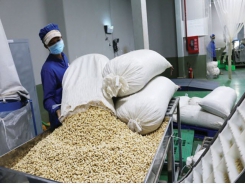Tea exports down in volume and value

Ô Long tea being processed by workers at Cầu Đất Tea Co in the central highland province of Lâm Đồng. - Photo vtv
HÀ NỘI — Việt Nam exported 120,000 tonnes of tea in 2018, earning revenue of US$219 million, a year-on-year decrease of 8.4 per cent in volume and 3.4 per cent in value, respectively.
The figure was revealed by the Import and Export Department, under the Ministry of Industry and Trade (MoIT).
Among the ten main export markets of Vietnamese tea in 2018, Pakistan is the largest, with imports of 33.25 thousand tonnes, reaching $71.98 million, increasing by 14.76 per cent in volume and 15.88 per cent in value. The average export price is $2,164.96 per tonne, up 0.98 per cent against 2017.
Taiwan ranked second by importing 17.35 thousand tonnes of tea from Việt Nam, worth $26.81 million, increasing 7.26 per cent in volume and 5.75 per cent in value, but the average export price decreased by 1.41 per cent compared to the previous year.
These are followed by Russia and China with 12.8 and 9.3 thousand tonnes, respectively, down 17.43 per cent and 9.21 per cent, respectively. In addition, Vietnamese tea products are also exported to markets such as Poland, India, Germany and Turkey.
The main export products are black tea, green tea, tea marinated with flowers and oolong tea.
MoIT’s Import and Export Department forecast that in 2019, tea export activities will continue to face many difficulties due to the pressure of oversupply in the world market. Many countries continue to expand production areas without paying attention to the fact that supply is outweighing market demand.
In 2019, the Food and Agriculture Organisation (FAO) of the United Nations estimates a surplus of about 75,000 tonnes of tea and this figure is expected to increase to 128,000 tonnes in 2020.
According to experts, to develop the tea industry, it is necessary to improve price competitiveness and pay more attention to product quality. Therefore, Việt Nam’s tea exporters need to invest more in deep processing technology of tea products, mixing with other drinks to create diverse flavors, reducing substances that cause side effects in tea, to keep up with changes in tea consumption tastes around the world.
Có thể bạn quan tâm
Phần mềm

Phối trộn thức ăn chăn nuôi

Pha dung dịch thủy canh

Định mức cho tôm ăn

Phối trộn phân bón NPK

Xác định tỷ lệ tôm sống

Chuyển đổi đơn vị phân bón

Xác định công suất sục khí

Chuyển đổi đơn vị tôm

Tính diện tích nhà kính

Tính thể tích ao hồ



 2018 rice exports Successful innovation
2018 rice exports Successful innovation  The cashew industry focuses on investing in quality…
The cashew industry focuses on investing in quality…